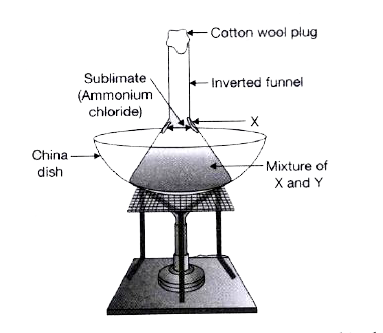Use the periodic table to answer the following questions.
a. Identify an element with five electrons in the outer subshell.
b. Identify an element that would tend to lose two electrons.
c. Identify an element that would tend to gain two electrons.
d. Identify the group having metal, non-metal, liquid as well as gas at the room temperature.
a. The general electronic configuration of the elements having five electrons in the outer subshell is ns2np5.This electronic configuration is characteristic of elements of group 17 i.e. hallogens and their examples are F,Cl,Br,I,At,etc.
b. The elements which have a tendency to lose two electrons must have two electrons in the valence shell. Therefore, their general configuration should be ns2. This electronic configuration is characterstic of group 2 elements, i.e. alkaline earth metals and their examples are Mg,Ca,Sr,Ba, etc.
c. The elements which have a tendency to accept two electrons must have four electrons in the valence shell. Therefore, their general electronic configuration is ns2np4. This electronic configuration is characteristic of group 16 elements and their examples are O,S,Se,Te etc.
d. A metal which is liquid at room temperature is mercury. It is a transition metal and belongs to group 12. A non-metal which is a gas at room temperature is nitrogen (group 15),oxygen (group 16),flurine, chlorine (group 17) and inert gases (group 18). A non-metal which is a liquid at room temperature is bromine (group 17).
Topper's Solved these Questions
- BOOK - CENGAGE CHEMISTRYCHAPTER - APPENDIX - INORGANIC VOLUME 1EXERCISE - Exercise very short70videos
APPENDIX - INORGANIC VOLUME 1
- BOOK - CENGAGE CHEMISTRYCHAPTER - APPENDIX - INORGANIC VOLUME 1EXERCISE - Exercise Short146videos
APPENDIX - INORGANIC VOLUME 1
- BOOK - CENGAGE CHEMISTRYCHAPTER - ALKYNESEXERCISE - Exercises (Archives - Analytical and Desriptive Type)4videos
ALKYNES
- BOOK - CENGAGE CHEMISTRYCHAPTER - ATOMIC STRUCTUREEXERCISE - Concept Applicationexercise(4.3)19videos
ATOMIC STRUCTURE
Similar Questions
Use the periodic table to answer the following questions.
a. Identify an element with five electrons in the outer subshell.
b. Identify an element that would tend to lose two electrons.
c. Identify an element that would tend to gain two electrons.
d. Identify the group having metal, non-metal, liquid as well as gas at the room temperature.View SolutionUse of Modern periodic table to answer the following questions:
(i) Identify an element with six electrons in the outermost shell.
(ii) Identify an element that would tend to lose one electron.
(ii) Identify an element that would tend to gain three electrons.
(iv) Identify the group having metal, non-metal, liquid as well as gas at 30∘C temperature.View SolutionExplain the following question (based on size of atoms or ions and other periodic properties):
a. Arrange the following species in decreasing order of their sizes//ionic radii.
i. Ar,K⊕,Clɵ,S2− and Ca2+
ii. Al3+,Mg2+,Na⊕,Clɵ,N3− and O2−
b. What are isoelectronic species? Name the species which are isoelectronic with each of the following atom or ions.
i. Rb⊕ ii. Fɵ, iii. Mg2+ iv. Ar
c. Arrange the following species/atoms in decreasing order of reducing character.
i. Na,Mg and Al ii. Mg,Ca and Sr
iii. Na,K and Rb iv. Fɵ,Clɵ,Brɵ and Iɵ
d. The decreasing order of reactivety of group 1 elements is Cs>Rb>K>Na>Li whereas that of group 17 elements is (Cl>F>Br>I). Explain.
e. Predict the formula of the stable binary compounds that would be formed by the combination of the following pairs of elements:
i. Mg and N
ii. Si and O
iii. Elements with Z=71 and F
iv. P and F
v. Al and I
vi. Li and O
f. Ansewer the following by the use of periodic table.
i. Identify the element that would tend to gain two electrons.
ii. Identify the group having metal, non-metal, liquid as well as gas at the room temperature,
iii. Identify the element with five electrons in the outer shell.
iv. Identify the element that would tend to lose two elctrons.View SolutionAn element has two electrons in N-shell. Identify the element.
View SolutionElement "X" has two electrons in its "M" shell.Identify the element.
View SolutionFrom the elements Li, K, Mg, C, Al, S identify the
element which has the tendency to lose two electrons.View SolutionRead the following statements and identify the elements :
A lustrous non-metal which has 7 electrons in its outermost shell.View SolutionIdentify, the elements with the following property
The metal which exists in liquid state at room temperature.View SolutionRead the following statements and identify the elements :
An element of group 15 and period 5 and also a semi-metal.View SolutionA mixture of two components X and Y. X is an element and Y is a compound of two non metals. Identify X and Y.
 View Solution
View Solution

